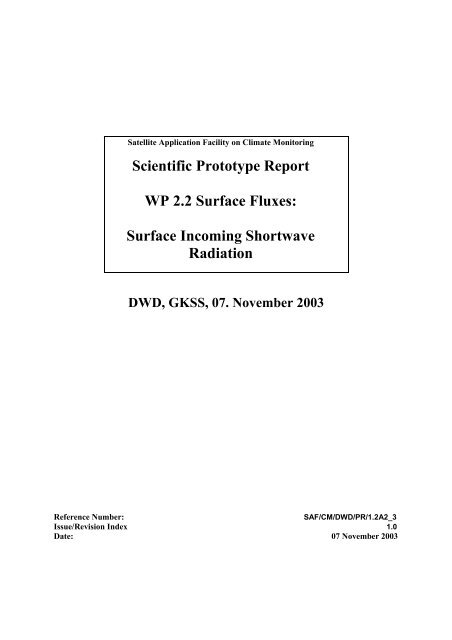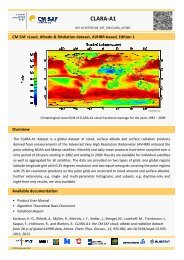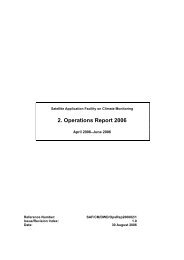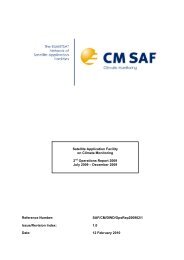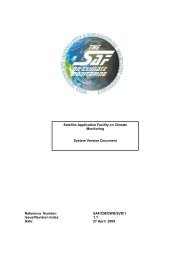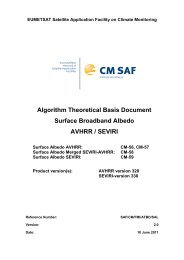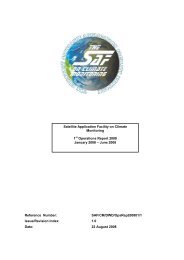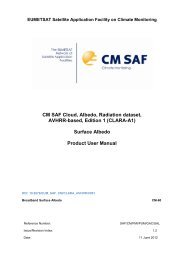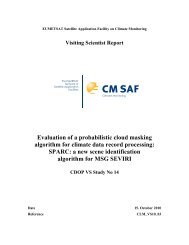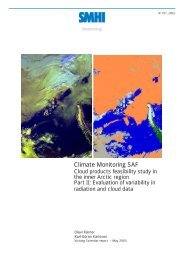1.0 - CM SAF
1.0 - CM SAF
1.0 - CM SAF
Create successful ePaper yourself
Turn your PDF publications into a flip-book with our unique Google optimized e-Paper software.
Satellite Application Facility on Climate Monitoring<br />
Scientific Prototype Report<br />
WP 2.2 Surface Fluxes:<br />
Surface Incoming Shortwave<br />
Radiation<br />
DWD, GKSS, 07. November 2003<br />
Reference Number:<br />
<strong>SAF</strong>/<strong>CM</strong>/DWD/PR/1.2A2_3<br />
Issue/Revision Index <strong>1.0</strong><br />
Date: 07 November 2003
<strong>SAF</strong> on Climate<br />
Monitoring<br />
Scientific Prototype Report<br />
Annex 2:<br />
WP 2.2 Surface Fluxes<br />
Doc.No.: <strong>SAF</strong>/<strong>CM</strong>/DWD/PR/1.2A2_3<br />
Issue: <strong>1.0</strong><br />
Date: 7 November 2003<br />
TABLE OF CONTENTS<br />
1. SHORTWAVE FLUXES ............................................................................................................... 3<br />
1.1 MODEL DESCRIPTION.................................................................................................................. 3<br />
1.2 INPUT DATA FOR PROTOTYPE ACTIVITES ................................................................................... 3<br />
1.2.1 ISCCP-DX data ................................................................................................................. 4<br />
1.2.2 E<strong>CM</strong>WF data..................................................................................................................... 4<br />
1.3 NARROW-TO-BROADBAND CONVERSION................................................................................... 4<br />
1.3.1 Conversion for METEOSAT for prototype development ................................................. 5<br />
1.3.2 Conversion for the NOAA-AVHRR instruments.............................................................. 5<br />
1.3.3 Description of method of Hucek and Jacobowitz (1995) .................................................. 6<br />
1.4 CALCULATION OF LOOK-UP TABLES FOR SIS............................................................................ 7<br />
1.4.1 Sensitivty studies for generation of look-up tables............................................................ 7<br />
1.4.2 Definition of look-up tables...............................................................................................9<br />
1.4.3 Comparison with other RTM results ............................................................................... 10<br />
1.5 PROTOTYPE DEVELOPMENT...................................................................................................... 12<br />
1.5.1 Usage of look-up tables within the prototype.................................................................. 12<br />
1.5.2 Surface albedo ................................................................................................................. 14<br />
1.5.3 Processing steps............................................................................................................... 14<br />
1.6 CALCULATION OF DAILY AVERAGES......................................................................................... 15<br />
1.7 PRELIMINARY VALIDATION RESULTS....................................................................................... 15<br />
1.8 FIRST RESULTS BASED ON AVHRR DATA................................................................................ 18<br />
1.9 NEXT STEPS .............................................................................................................................. 20<br />
1.10 REFERENCES ........................................................................................................................ 20<br />
2
<strong>SAF</strong> on Climate<br />
Monitoring<br />
Scientific Prototype Report<br />
Annex 2:<br />
WP 2.2 Surface Fluxes<br />
Doc.No.: <strong>SAF</strong>/<strong>CM</strong>/DWD/PR/1.2A2_3<br />
Issue: <strong>1.0</strong><br />
Date: 7 November 2003<br />
1. SHORTWAVE FLUXES<br />
The following chapters describe the prototyping activities for the surface incoming shortwave flux.<br />
1.1 MODEL DESCRIPTION<br />
For the calculation of the surface incoming shortwave flux (SIS) an algorithm similar to the one<br />
developed by Pinker (e.g. Pinker and Laszlo, 1992) was developed. The basic idea for the algorithm is<br />
that a relationship exists between the broadband (0.2-4.0 µm) atmospheric transmittance and the<br />
reflectance at the top of the atmosphere (TOA). Once the transmittance is determined from the TOA<br />
albedo, the surface irradiance SIS can be computed from the incoming solar flux at the top of the<br />
atmosphere E<br />
0<br />
and the atmospheric transmittance T . <br />
0<br />
is the sun zenith angle.<br />
SIS E0 cos( 0<br />
) T<br />
With a radiative transfer model, the broadband atmospheric transmittance is calculated once in<br />
relationship to the broadband TOA albedo for a variety of atmospheric and surface states. The actual<br />
computation of the surface irradiance involves two steps. First the broadband TOA albedo is<br />
determined from the satellite measurement. Then the atmospheric transmittance is determined from the<br />
TOA albedo together with information on the atmospheric and surface state from the precomputed<br />
tables.<br />
Input parameters into the algorithm are the broadband TOA albedo, solar zenith angle, surface albedo,<br />
the cloud mask, additional cloud properties as e.g. the cloud optical depth if available, aerosol and<br />
ozone data and the total water vapour content of the atmosphere. The broadband TOA albedo for the<br />
area covered by the MSG satellite, the surface albedo and the cloud properties are derived by other<br />
groups within the <strong>CM</strong>-<strong>SAF</strong>. All other input data are either from climate data sets (aerosol, ozone) or<br />
NWP-data (water vapour). Depending on the availability of appropriate data sets, satellite derived<br />
values could be used instead of the climate values. To calculate the TOA albedo for the <strong>CM</strong>-<strong>SAF</strong><br />
region not covered by the MSG satellite, a narrow-to-broadband conversion of the satellite data and<br />
the application of an angular directional model is necessary. In using broadband fluxes at the top of the<br />
atmosphere, the algorithm is independent of the satellite instrument and allows for the application to<br />
multiple sensors (here MSG/SEVIRI and AVHRR).<br />
1.2 INPUT DATA FOR PROTOTYPE ACTIVITES<br />
In order to have consistency between the cloud and radiation products, <strong>CM</strong>-<strong>SAF</strong> cloud products will<br />
be used as input into the surface flux calculations. The <strong>CM</strong>-<strong>SAF</strong> cloud products will be based on MSG<br />
data for the <strong>CM</strong>-<strong>SAF</strong> area within the MSG field of view and on AVHRR data for the <strong>CM</strong>-<strong>SAF</strong> area<br />
outside the MSG field of view. As the cloud software was still in the tuning and evaluation stage<br />
during the development of the SIS prototype, alternative cloud products have been selected for the<br />
present prototyping activities. They are the ISCCP-DX datasets from 5 different months from 1993 to<br />
December 1997 and corresponding E<strong>CM</strong>WF analysis data from the same time period. These data sets<br />
have been used to test the prototype software.<br />
Figure 1 gives an overview of the general processing within the SIS prototype:<br />
3
<strong>SAF</strong> on Climate<br />
Monitoring<br />
Scientific Prototype Report<br />
Annex 2:<br />
WP 2.2 Surface Fluxes<br />
Doc.No.: <strong>SAF</strong>/<strong>CM</strong>/DWD/PR/1.2A2_3<br />
Issue: <strong>1.0</strong><br />
Date: 7 November 2003<br />
Background data<br />
& maps<br />
e.g. spec. albedo maps,<br />
surface type<br />
Satellite Data<br />
sza,<br />
_sfc<br />
toa<br />
E<strong>CM</strong>WF analyses<br />
Int. water vapour<br />
Lookuptable for<br />
SIS = f (sza, _sfc_toa,...)<br />
Precalculated<br />
Model runs<br />
of SHDOM<br />
for N atmosph.<br />
conditions<br />
Inst. SIS<br />
Figure 1: Overview of processing for SIS-calculations.<br />
1.2.1 ISCCP-DX DATA<br />
The International Satellite Cloud Climatology Project (ISCCP, see e.g. Rossow and Schiffer, 1991)<br />
uses data from geostationary and polar orbiting weather satellites to derive a global cloud climatology.<br />
The ISCCP-DX data are sampled in space and time to reduce the data volume. The satellite<br />
observations are available every 3 hours. The pixels of the satellites are sampled to a spacing of about<br />
30 km. For Meteosat, this means every 6 th pixel is used, which gives a spacing of about 50 km and a<br />
pixel size of about 8 km in midlatitudes. The SIS algorithm uses the cloud flag, the narrowband<br />
radiance of the visible channel and corresponding viewing geometry information.<br />
For the validation, so far only Meteosat cloud data have been used. For the monthly mean gridded<br />
image, all available (in space and time) Meteosat data have been used. At first the instantaneous data<br />
were gridded to a 0.167° x 01.67° rectangular latitude/longitude grid. All pixels in a grid box were<br />
averaged. The final results are presented in 0.5° x 0.5° rectangular grid.<br />
1.2.2 E<strong>CM</strong>WF DATA<br />
E<strong>CM</strong>WF analysis data were used for the atmospheric variables temperature and humidity. E<strong>CM</strong>WF<br />
analysis data are available in a 0.5625° x 0.5625° rectangular latitude/longitude grid in 31 levels,<br />
which can be related to pressure levels. From the atmospheric profiles, total precipitable water was<br />
calculated. Additionally, the surface temperature is used for classification of the atmospheric state. For<br />
the MSG and AVHRR processing NWP data from the DWD global forecast model GME will be used.<br />
1.3 NARROW-TO-BROADBAND CONVERSION<br />
The calculation of the TOA albedo from satellite radiances requires a narrow-to-broadband (NTB)<br />
radiance conversion and the use of angular distribution models to convert radiance into flux. For<br />
SEVIRI the TOA flux will be provided by another group within the <strong>CM</strong>-<strong>SAF</strong> (RMIB). For other<br />
sensors the conversion from radiance to flux needs to be included in the surface flux processing. The<br />
4
<strong>SAF</strong> on Climate<br />
Monitoring<br />
Scientific Prototype Report<br />
Annex 2:<br />
WP 2.2 Surface Fluxes<br />
Doc.No.: <strong>SAF</strong>/<strong>CM</strong>/DWD/PR/1.2A2_3<br />
Issue: <strong>1.0</strong><br />
Date: 7 November 2003<br />
following two chapters describe the NTB conversion for METEOSAT and AVHRR. For both sensors<br />
the ERBE angular distribution models were used (Suttles, et al., 1988).<br />
1.3.1 CONVERSION FOR METEOSAT FOR PROTOTYPE DEVELOPMENT<br />
For prototype testing of SIS METEOSAT-5 data of the ISCCP-DX data set from the August 1995<br />
period was primarily used. For the narrow-to-braodband conversion of the METEOSAT-5 radiances<br />
the conversion developed by Gimeno-Ferrer et al. (2001) was used. The authors derived the broadband<br />
shortwave radiance (L SW ) as a function of the visible radiance of METEOSAT channel 1 (L VIS ) and the<br />
cosine of the solar zenith angle µ. The conversion is based on radiative transfer calculations with the<br />
STREAMER model (Key, 1998) and is independent of scene type. The following equation was<br />
derived:<br />
L<br />
SW<br />
a<br />
1<br />
0<br />
a1<br />
a2<br />
ln(<br />
<br />
)<br />
L<br />
VIS<br />
a<br />
4<br />
L<br />
2<br />
VIS<br />
where the a i are regression coefficients:<br />
a 0 =0.99 a 1 =2.428<br />
a 3 =-0.220 a 4 =-0.00328<br />
Table 1: Regression coefficients for the NTB-conversion.<br />
The calculations for 1993 with METEOSAT-4 data and the calculations for 1997 with METEOSAT-6<br />
were also performed with this NTB conversion.<br />
1.3.2 CONVERSION FOR THE NOAA-AVHRR INSTRUMENTS<br />
For areas outside the field of view of MSG, the broadband albedo will be calculated from the AVHRR<br />
channel 1 and channel 2 radiances. Based on a theoretical study conducted by the OSI-<strong>SAF</strong> (Øystein<br />
and Eastwood, 2002) a validation study was performed in the <strong>CM</strong>-<strong>SAF</strong> to investigate which narrowto-broadband<br />
conversion method performs best (Kryvobok and Hollmann, 2003). Four different NTB<br />
conversion methods were compared with co-located and co-aligned measurements of the broadband<br />
measuring instrument ScaRaB (Scanner for Radiation Budget) for some months in 1994. For the<br />
comparison, all AVHRR pixels within each ScaRab pixel were averaged, weighted by the ScaRab<br />
point spread function. The area of investigation concentrated mainly on Europe (Figure 2).<br />
Figure 2: Geographical distribution of pixels (area is indicated by black horizontal lines) used to test<br />
narrow to broadband conversions.<br />
5
<strong>SAF</strong> on Climate<br />
Monitoring<br />
Scientific Prototype Report<br />
Annex 2:<br />
WP 2.2 Surface Fluxes<br />
Doc.No.: <strong>SAF</strong>/<strong>CM</strong>/DWD/PR/1.2A2_3<br />
Issue: <strong>1.0</strong><br />
Date: 7 November 2003<br />
Testing of the four different NTB corrections shows that the method of Hucek and Jacobowitz (1995)<br />
gives the best estimation of reflected shortwave flux at the top of atmosphere from AVHRR narrowband<br />
channel data. This method gives a mean difference of 1.8 W/m 2 , the standard deviation is 48.0<br />
W/m 2 and the relative error is 0.12. The one channel NTB correction of Hollmann et al. (1998) is<br />
better than the non scene-dependent method of Wydick (1987) (Table 2). It has to be noted, that in this<br />
comparison also the errors of angular directional model after Suttles et al (1988) are implicitly<br />
included.<br />
NTB correction<br />
M_DIFF,<br />
R_ER<br />
W/m 2 ,<br />
W/m 2<br />
Wydick -37.2 73.0 0.20<br />
Li & Leighton 43.1 75.6 0.21<br />
Hucek & Jacobowitz -1.8 48.0 0.12<br />
Hollmann -12.3 67.7 0.16<br />
Table 2: Summary of statistics of AVHRR prediction of broadband flux for different NTB corrections,<br />
all measurement. M_DIFF=average mean difference, =standard deviation, R_ER=relative error.<br />
From the comparison it could be shown that the accuracy of a method depends more on the surface<br />
type and on cloud cover than on the number of channels used. AVHRR – ScaRaB flux differences<br />
were also evaluated with respect to different observational conditions, using the Hucek and Jacobowitz<br />
NTB correction. The smallest errors appear for those measurements which are coincident in time,<br />
collocated, co-angular and over the same scene type . For the case when the difference in time was less<br />
than 10 min, difference in space geolocation angles was less than 10 and for land cases an mean<br />
difference of 1.13 W/m 2 , a standard deviation of 6.9 W/m 2 and a relative error of 0.04 was found.<br />
Based upon the validation results the method of Hucek and Jacobowitz (1995) was selected as NTB<br />
correction for the developed software to calculate the top of atmosphere broadband albedo from<br />
AVHRR data.<br />
1.3.3 DESCRIPTION OF METHOD OF HUCEK AND JACOBOWITZ (1995)<br />
The NTB conversions of Hucek and Jacobowitz (1995) were developed based upon coincident<br />
narrowband (AVHRR) and broadband (ERBE) observations made by NOAA-9. The model takes into<br />
account surface geography type and cloud amount (Table 3).<br />
Coefficient Surface type<br />
Snow Ocean Land Desert Coast<br />
Clear<br />
A 3.8995 1.78 2.17 2.60 2.77<br />
B 1 0.0520 1.3302 0.3999 0.3896 0.3779<br />
B 2 0.7423 -0.6250 0.4333 0.3873 0.4168<br />
Partly cloudy<br />
A - 4.11 4.24 3.12 4.65<br />
B 1 - 0.9029 0.3166 0.2705 0.3085<br />
B 2 - -0.244 0.3948 0.4811 0.3856<br />
Mostly cloudy<br />
A - 5.08 4.75 5.49 5.36<br />
B 1 - 0.4711 0.3757 0.3255 0.4362<br />
B 2 - 0.2983 0.3870 0.3961 0.3227<br />
Overcast<br />
A -0.1174 8.19 6.98 7.50 7.79<br />
B 1 -0.0650 0.2301 0.2566 0.7564 0.2930<br />
6
<strong>SAF</strong> on Climate<br />
Monitoring<br />
Scientific Prototype Report<br />
Annex 2:<br />
WP 2.2 Surface Fluxes<br />
Doc.No.: <strong>SAF</strong>/<strong>CM</strong>/DWD/PR/1.2A2_3<br />
Issue: <strong>1.0</strong><br />
Date: 7 November 2003<br />
Coefficient Surface type<br />
Snow Ocean Land Desert Coast<br />
B 2 0.8671 0.5032 0.4907 -0.0136 0.4446<br />
Table 3: Regression coefficients for the surface type and cloud amount dependent model of Hucek and<br />
Jacobowitz (1995)<br />
1.4 CALCULATION OF LOOK-UP TABLES FOR SIS<br />
In the <strong>CM</strong>-<strong>SAF</strong> shortwave radiative transfer calculations in cloudy skies were needed for the<br />
development of the cloud optical thickness prototype and the surface incoming shortwave radiation<br />
prototype. In order to keep a high degree of consistency, it was decided to use the same radiative<br />
transfer for both purposes. Based on an comparison study (Roebeling et al., 2002; Frerichs et al.,<br />
2002) the radiative transfer model SHDOM was selected as the baseline algorithm. The radiative<br />
transfer model to be used in the look-up table (LUT) generation is therefore the Spherical Harmonics<br />
Discrete Ordinate Method (SHDOM), a highly efficient and flexible algorithm suitable for radiative<br />
transfer modelling (RTM) in inhomogeneous three-dimensional media (Evans, 1998). Some of the<br />
major features of this RTM can be summarised as follows:<br />
The radiance field is represented both in spherical harmonics and discrete ordinates during different<br />
parts of the iterative solution algorithm.<br />
The model can perform 1D, 2D and 3D unpolarised radiative transfer, and the optical properties of<br />
the medium can be specified at every grid point within the atmosphere: extinction, single-scattering<br />
albedo, Legendre series of the phase function and temperature.<br />
The source function and radiance are defined on discrete grid points.<br />
After implementation of the SHDOM program, the look-up table generation followed several steps<br />
(Gimeno-Ferrer and Hollmann, 2002):<br />
1. Analysis of the trade-off between the accuracy in the results and the computing time,<br />
2. Study of the sensitivity of key parameters in the results,<br />
3. Selection of appropriate variables and their variation range, and<br />
4. Running the RTM to generate the look-up tables.<br />
1.4.1 SENSITIVTY STUDIES FOR GENERATION OF LOOK-UP TABLES<br />
In order to select the adequate variables and their variation range for the LUT generation, some<br />
sensitivity studies have been carried out. SHDOM was run in 1D mode (plane-parallel atmosphere).<br />
Broadband simulations were carried out in the six Fu´s shortwave bands (Table 4) and the model<br />
output were hemispheric fluxes and net flux divergences (heating rates). Atmospheric transmissivity<br />
and TOA albedo was also computed. Three general atmospheric situations were considered: clear sky<br />
without aerosols (Rayleigh atmosphere), clear sky with aerosol layers and aerosol-free cloudy sky.<br />
Aerosols have been taken into account in the radiative transfer simulations by filling the troposphere<br />
with two aerosol layers, one layer of homogeneous number concentration in the planetary boundary<br />
layer and another one just above extending to the tropopause with an exponentially decreasing number<br />
concentration profile. Clouds are considered setting one single water cloud layer between 1 and 2 km<br />
height, with cloud droplets following a modified gamma size distribution with an effective variance of<br />
0.15.<br />
The variables of interest for the sensitivity studies are water vapour content, ozone column, cloud<br />
droplet effective radius, cloud optical depth, and aerosol optical depth. Other parameters such as sun<br />
zenith angle, surface lambertian albedo, atmospheric profiles and aerosol type were selected without<br />
previous in-depth studies. The sensitivity studies have been performed computing the transmissivity<br />
and TOA albedo for the first three variables above, whereas for optical depths, cloud (aerosol)<br />
radiative forcing at the TOA and the surface was computed:<br />
7
<strong>SAF</strong> on Climate<br />
Monitoring<br />
Scientific Prototype Report<br />
Annex 2:<br />
WP 2.2 Surface Fluxes<br />
Doc.No.: <strong>SAF</strong>/<strong>CM</strong>/DWD/PR/1.2A2_3<br />
Issue: <strong>1.0</strong><br />
Date: 7 November 2003<br />
<br />
0 0 <br />
RF F F F F<br />
where the equation above should be applied at the level of interest. Figure 3 displays some results, in<br />
whose interpretation it should be taken into account that increasing bands contain decreasing incoming<br />
energy at the TOA (Table 4).<br />
Band Spectral interval (m) TOA normal flux (W/m 2 )<br />
1 0.2 - 0.7 627.50<br />
2 0.7 - 1.3 490.50<br />
3 1.3 - 1.8 151.80<br />
4 1.8 - 2.5 49.35<br />
5 2.5 - 3.5 32.06<br />
6 3.5 - 4.0 5.87<br />
Shortwave 0.2 - 4.0 1357.08<br />
Table 4: Incoming TOA normal fluxes for Fu´s bands.<br />
0.5<br />
Band 1<br />
0.15<br />
Band 2<br />
0.14<br />
0.4<br />
0.13<br />
0.12<br />
TOA Albedo<br />
0.3<br />
0.2<br />
TOA Albedo<br />
0.11<br />
0.10<br />
0.09<br />
0.1<br />
SZA=0<br />
SZA=20<br />
SZA=40<br />
SZA=50<br />
SZA=80<br />
0.08<br />
0.07<br />
0.06<br />
SZA=0<br />
SZA=20<br />
SZA=40<br />
SZA=50<br />
SZA=80<br />
0.0<br />
0.5 <strong>1.0</strong> 1.5 2.0 2.5 3.0 3.5 4.0<br />
0.05<br />
0.5 <strong>1.0</strong> 1.5 2.0 2.5 3.0 3.5 4.0<br />
Water vapour (g/cm 2 )<br />
Water vapour (g/cm 2 )<br />
0.060<br />
Band 3<br />
0.08<br />
Band 4<br />
0.055<br />
0.07<br />
0.050<br />
TOA Albedo<br />
0.045<br />
0.040<br />
0.035<br />
SZA=0<br />
SZA=20<br />
SZA=40<br />
SZA=50<br />
SZA=80<br />
TOA Albedo<br />
0.06<br />
0.05<br />
SZA=0<br />
SZA=20<br />
SZA=40<br />
SZA=50<br />
SZA=80<br />
0.030<br />
0.5 <strong>1.0</strong> 1.5 2.0 2.5 3.0 3.5 4.0<br />
0.04<br />
0.5 <strong>1.0</strong> 1.5 2.0 2.5 3.0 3.5 4.0<br />
Water vapour (g/cm 2 )<br />
Water vapour (g/cm 2 )<br />
8
<strong>SAF</strong> on Climate<br />
Monitoring<br />
Scientific Prototype Report<br />
Annex 2:<br />
WP 2.2 Surface Fluxes<br />
Doc.No.: <strong>SAF</strong>/<strong>CM</strong>/DWD/PR/1.2A2_3<br />
Issue: <strong>1.0</strong><br />
Date: 7 November 2003<br />
0.020<br />
Band 5<br />
0.10<br />
Band 6<br />
0.09<br />
0.015<br />
TOA Albedo<br />
0.010<br />
TOA Albedo<br />
0.08<br />
0.07<br />
0.005<br />
SZA=0<br />
SZA=20<br />
SZA=40<br />
SZA=50<br />
SZA=80<br />
0.06<br />
SZA=0<br />
SZA=20<br />
SZA=40<br />
SZA=50<br />
SZA=80<br />
0.000<br />
0.5 <strong>1.0</strong> 1.5 2.0 2.5 3.0 3.5 4.0<br />
0.05<br />
0.5 <strong>1.0</strong> 1.5 2.0 2.5 3.0 3.5 4.0<br />
Water vapour (g/cm 2 )<br />
Water vapour (g/cm 2 )<br />
Figure 3:TOA albedo vs. water vapour content for different bands and sun zenith angles. The fixed<br />
scene parameters are: surface albedo of 0.1 and clear-sky mid-latitude summer atmosphere with 335<br />
DU of ozone column without aerosols.<br />
Water vapour (Figure 3) shows an important influence in the results for all bands, excepting band 1.<br />
Cloud optical properties impact on the results seem to saturate within the studied range of variation.<br />
Finally, aerosol optical depth variation range does not saturate the simulated results. However, this<br />
range covers the typically observed values for this magnitude (e.g. Dubovik et al., 2002).<br />
1.4.2 DEFINITION OF LOOK-UP TABLES<br />
The definition of the LUT is based on the performed sensitivity studies and on other physical and<br />
mathematical reasons, e.g., the physically meaningful sampling of variables for further interpolation<br />
when the LUT is used for SIS retrieval. Tables Table 5 and Table 6 show the definition of the LUT for<br />
both clear and cloudy sky.<br />
Parameter Variation range Number of cases<br />
Band 6 Fu´s bands 6<br />
Atmosphere TRO, MLS, MLW, SAS, SAW, USS 6<br />
SZA 0, 10, 20, 30, 40, 50, 60, 70, 80° 9<br />
Surface albedo 0, 0.05, 0.1, 0.2, 0.3, 0.5, 1 8<br />
Aerosol type 10 pure standard components + no aerosols 10 + 1<br />
Aerosol OD 0.01, 0.05, 0.1, 0.5, 1, 5 + no aerosols 6 + 1<br />
Water vapour 25, 50, 75 and 100% of standard column + saturation 5<br />
Ozone column 75, 100 and 125% of standard column 3<br />
2371680<br />
Table 5: Look-up table definition for clear sky.<br />
Parameter Variation range Number of cases<br />
Band 6 Fu´s bands 6<br />
Atmosphere TRO, MLS, MLW, SAS, SAW, USS 6<br />
SZA 0, 10, 20, 30, 40, 50, 60, 70, 80° 9<br />
Surface albedo 0, 0.05, 0.1, 0.2, 0.3, 0.5, 1 8<br />
Cloud OD 0.5, 1, 2, 4, 8, 16, 32, 64, 128 9<br />
Effective radius 1, 3, 5, 8, 12, 16, 24 µm 7<br />
9
<strong>SAF</strong> on Climate<br />
Monitoring<br />
Scientific Prototype Report<br />
Annex 2:<br />
WP 2.2 Surface Fluxes<br />
Doc.No.: <strong>SAF</strong>/<strong>CM</strong>/DWD/PR/1.2A2_3<br />
Issue: <strong>1.0</strong><br />
Date: 7 November 2003<br />
Parameter Variation range Number of cases<br />
Water vapour 25, 50, 75 and 100% of standard column + saturation 5<br />
Ozone column 75, 100 and 125% of standard column 3<br />
2449440<br />
Table 6: Look-up table definition for cloudy sky.<br />
The aerosol optical and physical properties are taken from the OPAC (Optical Properties of Aerosols<br />
and Clouds) database (Hess et al., 1998). Aerosol particles are supposed to follow a log-normal size<br />
distribution.<br />
The size distribution parameters of the aerosol types to be simulated are summarised in Table 7. The<br />
integrated columns of water vapour and ozone are varied as a rounded percentage of the standard<br />
values of the different atmospheres. Thus, their actual values are different for each of these<br />
atmospheres (Table 8). The saturation value for water vapour is included as the higher amount of<br />
water vapour that every atmosphere is able to hold before reaching saturation at any level. The<br />
variation ranges of all the variables are expected to cover realistic and typical values of these<br />
magnitudes, though some extreme values are also included, like high optical depths, low cloud droplet<br />
effective radius or non-usual aerosol types.<br />
Aerosol type Effective radius (µm) Effective variance r max (µm) r min (µm)<br />
Insoluble 0.702 0.173 0.005 20.0<br />
Water-soluble 0.032 0.178 0.005 20.0<br />
Soot 0.015 0.095 0.005 20.0<br />
Sea salt (acc. mode) 0.265 0.099 0.005 20.0<br />
Sea salt (coa. mode) 2.217 0.099 0.005 60.0<br />
Mineral (nuc. mode) 0.086 0.088 0.005 20.0<br />
Mineral (acc. mode) 0.489 0.095 0.005 20.0<br />
Mineral (coa. mode) 2.505 0.117 0.005 60.0<br />
Mineral-transported 0.670 0.124 0.020 5.0<br />
Sulfate droplets 0.088 0.099 0.005 20.0<br />
Table 7: Size distribution parameters for the simulated aerosol types in dry state. r max and r min are the<br />
upper and lower limits of the particle sizes taken into account for Mie calculations.<br />
Atmosphere Water vapour columns (g/cm 2 ) Ozone columns (DU)<br />
TRO <strong>1.0</strong>0, 2.00, 3.00, 4.00, 5.55 215, 285, 355<br />
MLS 0.75, 1.50, 2.25, 3.00, 3.95 250, 335, 420<br />
MLW 0.20, 0.40, 0.60, 0.80, 1.10 285, 380, 475<br />
SAS 0.50, <strong>1.0</strong>0, 1.50, 2.00, 2.80 260, 350, 440<br />
SAW 0.10, 0.20, 0.30, 0.40, 0.50 280, 375, 470<br />
USS 0.35, 0.70, <strong>1.0</strong>5, 1.40, 2.75 260, 345, 430<br />
Table 8: Water vapour and ozone columns used for the look-up table generation for every atmosphere.<br />
1.4.3 COMPARISON WITH OTHER RTM RESULTS<br />
As a quality check some of the RTM results have been compared to results from another radiative<br />
transfer model. The comparison was done with tabulated values of calculations performed with the Fu-<br />
Liou (Fu and Liou, 1992) radiative transfer model (http://snowdog.larc.nasa.gov/~rose/flp0602/).<br />
10
<strong>SAF</strong> on Climate<br />
Monitoring<br />
Scientific Prototype Report<br />
Annex 2:<br />
WP 2.2 Surface Fluxes<br />
Doc.No.: <strong>SAF</strong>/<strong>CM</strong>/DWD/PR/1.2A2_3<br />
Issue: <strong>1.0</strong><br />
Date: 7 November 2003<br />
Generally the comparison showed a good agreeement. Figure 4 and Figure 5 show two selected results<br />
from the comparison, one for clear-sky and one for cloudy sky situation.<br />
MLS; WASO = Aerosol Typ: 2; Transmissionen<br />
Albedo: 0.3; WD-Gehalt: 1.5; O 3 : 335 ppm v<br />
Aers. op.T. 0.01 Aers. op.T. 0.05<br />
Aers. op.T. 0.1 Aers. oT. 0.25<br />
Aers. oT. 0.4 Aers. oT. 0.6<br />
Aers. op.T. 1 Aers. op.T. 5<br />
Diagonale<br />
90%<br />
80%<br />
70%<br />
60%<br />
SHDOM<br />
50%<br />
40%<br />
30%<br />
20%<br />
10%<br />
0%<br />
0% 10% 20% 30% 40% 50% 60% 70% 80% 90%<br />
Fu-Liou<br />
Figure 4: Comparison of atmospheric transmission for midlatitude summer atmosphere with a water<br />
soluble aerosol and different values of the aerosol optical depth<br />
11
<strong>SAF</strong> on Climate<br />
Monitoring<br />
Scientific Prototype Report<br />
Annex 2:<br />
WP 2.2 Surface Fluxes<br />
Doc.No.: <strong>SAF</strong>/<strong>CM</strong>/DWD/PR/1.2A2_3<br />
Issue: <strong>1.0</strong><br />
Date: 7 November 2003<br />
MLS; cloud vis. optical depth: 8.0;<br />
Albedo: 0.3; WD-Gehalt: 2.8; O 3 : 344 ppm v<br />
Re = 5<br />
Re = 8<br />
Re = 12<br />
Diagonale<br />
90%<br />
80%<br />
70%<br />
60%<br />
50%<br />
40%<br />
30%<br />
20%<br />
10%<br />
0%<br />
0% 10% 20% 30% 40% 50% 60% 70% 80% 90%<br />
Figure 5: Comparison of atmospheric transmission for midlatitude summer atmosphere with a cloud<br />
optical depth of 8 and three different values of the cloud particel effective radius R e<br />
1.5 PROTOTYPE DEVELOPMENT<br />
1.5.1 USAGE OF LOOK-UP TABLES WITHIN THE PROTOTYPE<br />
For use in the prototype, the look-up tables were further processed.<br />
1. Integration over the 6 spectral Fu-Liou bands<br />
The above defined LUT’s were integrated for each of the 20 IGBP spectral surface albedos to come to<br />
a an easier and faster accessible LUT. For use with the MSG /NOAA prototype, the IGBP classes<br />
were related to the USGS land use classes.<br />
2. Definition of aerosol composit types for clear sky cases<br />
The RTM results for the basic aerosol types were combined to typical results for aerosol composits as<br />
e.g. “continental average” or “maritime clean”. The composition of the compound aerosol types from<br />
the pure aerosol types is based on Hess et al. (1998). The following Table 9 gives an overview of the<br />
10 derived aerosol types and their composition.<br />
Aerosoltype Nr. Number weighted composition of basic aerosols<br />
Continental clear 1 Insoluble aerosol/ water-soluble aerosol<br />
Continental average 2 Insoluble aerosol/ water-soluble aerosol/ soot<br />
Continental polluted 3 Insoluble aerosol/ water-soluble aerosol/ soot<br />
Urban 4 Insoluble aerosol/ water-soluble aerosol/ soot<br />
12
<strong>SAF</strong> on Climate<br />
Monitoring<br />
Scientific Prototype Report<br />
Annex 2:<br />
WP 2.2 Surface Fluxes<br />
Doc.No.: <strong>SAF</strong>/<strong>CM</strong>/DWD/PR/1.2A2_3<br />
Issue: <strong>1.0</strong><br />
Date: 7 November 2003<br />
Aerosoltype Nr. Number weighted composition of basic aerosols<br />
Desert 5 Water-soluble aerosol/ mineral (nucl. mode)/ mineral (acc.<br />
mode)/ mineral (coarse mode)<br />
Maritim clear 6 Water-soluble aerosol/ Sea salt (acc. mode)/sea salt (coarse<br />
mode)<br />
Maritim polluted 7 Water-soluble aerosol/ soot/ sea salt (acc. mode) /<br />
sea salt (coarse mode)<br />
Maritim tropical 8 Water-soluble aerosol/ Sea salt (acc. mode)/sea salt (coarse<br />
mode)<br />
Arctic 9 Insoluble aerosol/ water-soluble aerosol/ soot/ sea salt (acc.<br />
mode)<br />
Antarctic 10 Sea salt (acc. mode)/ mineral transported/ sulfate droplets<br />
Table 9: Composition of different aerosol types after OPAC.<br />
For the time being to each IGBP surface class a aerosol type after Table 10 is assigned.<br />
IGBP Surface Type Nr. Assigned aerosol type<br />
EVERGREEN NEEDLE FOREST 1 Continental clear<br />
EVERGREEN BROAD FOREST 2 Continental clear<br />
DECIDUOUS NEEDLE FOREST 3 Continental average<br />
DECIDUOUS BROAD FOREST 4 Continental average<br />
MIXED FOREST 5 Continental average<br />
CLOSED SHRUBS 6 Continental average<br />
OPEN/SHRUBS 7 Continental average<br />
WOODY SAVANNA 8 Continental average<br />
SAVANNA 9 Continental average<br />
GRASSLAND 10 Continental average<br />
WETLAND 11 Maritime polluted<br />
CROPLAND (CAGEX-APR) 12 Continental average<br />
URBAN 13 Urban<br />
CROP MOSAIC 14 Continental average<br />
ANTARCTIC SNOW 15 Antarctic<br />
BARREN/DESERT 16 Desert<br />
OCEAN WATER 17 Maritime clear<br />
TUNDRA 18 Continental clear<br />
FRESH SNOW 19 Antarctic<br />
SEA ICE 20 Arctic<br />
Table 10: Aerosol type for each surface type.<br />
For the prototype processing this gives finally LUT’s depending an 20 IGBP surface types. The<br />
advantage of this preprocessing is a a much faster processing within the prototype.<br />
13
<strong>SAF</strong> on Climate<br />
Monitoring<br />
Scientific Prototype Report<br />
Annex 2:<br />
WP 2.2 Surface Fluxes<br />
Doc.No.: <strong>SAF</strong>/<strong>CM</strong>/DWD/PR/1.2A2_3<br />
Issue: <strong>1.0</strong><br />
Date: 7 November 2003<br />
1.5.2 SURFACE ALBEDO<br />
For the prototype algorithm a synthetical background broadband surface albedo based on spectral<br />
surface properties results obtained by the CERES SRB team is used (http://wwwsurf.larc.nasa.gov/surf).<br />
They collected spectral surface properties from a broad range of authors<br />
and combined them for the 20 IGBP classes and the 6 Fu-Liou bands covering the solar<br />
spectral domain. This gives the spectral shape of the surface albedo and an integrated<br />
broadband surface albedo for a fixed sun zenith angle of 60°. To account for changes in the<br />
sun zenith angle the broadband surface albedo is varied with the cosine of the sun zenith<br />
angle µ:<br />
1<br />
d(<br />
igbp)<br />
<br />
SFC<br />
<br />
60<br />
1<br />
2d<br />
( igbp)<br />
<br />
where d depends on the chosen IGBP-surface type. For cloudy conditions no sun zenith angle<br />
correction is done and an integrated value for the surface albedo is used. Within the MSG/NOAA<br />
prototype, this background surface albedo will be scaled by the surface albedo derived within the <strong>CM</strong>-<br />
<strong>SAF</strong>.<br />
1.5.3 PROCESSING STEPS<br />
Two versions of the prototype software are presently available, one to process ISCCP-DX and the<br />
other to process MSG/SEVIRI or NOAA/AVHRR data. The basic modules for the calculation of the<br />
solar radiation are the same, but the interfaces are different.<br />
The following input data are required for processing:<br />
- cloud mask data<br />
- broadband TOA albedo<br />
- surface albedo (if available)<br />
- land use data<br />
- latitude, longitude data for every satellite pixel<br />
- sun zenith angle<br />
- NWP data<br />
- precipitable water calculated from NWP data<br />
- solar constant<br />
- ozone content (presently static)<br />
- cloud effective radius (presently static)<br />
- aerosol type (presently only depending on the land use class)<br />
- look-up tables<br />
For each satellite pixel, the atmosphere to be used for interpolation in the LUTs is determined from<br />
surface temperature and water vapour content of the atmosphere. From the surface type the surface<br />
albedo is determined, which, as mentionend in chapter 1.5.2 will be scaled to the actual surface albedo<br />
if it is available. Then the atmospheric transmittance is interpolated from the LUTs with a linear<br />
interpolation scheme for clear sky or cloudy sky cases dependent on the cloud mask. From the<br />
transmittance SIS is calculated according to equation 1. Interpolation in the clear and cloudy LUTs<br />
returns values of the aerosol and cloud optical thickness. They may not represent realistic aerosol or<br />
cloud optical thickness values but instead include residual errors made by assuming certain<br />
atmospheric conditions at a pixel location and trying to match the measured radiances to the assumed<br />
atmospheric state. However a comparison between cloud optical thickness derived from the<br />
interpolation with the ISCCP derived cloud optical thickness values shows comparable results.<br />
14
<strong>SAF</strong> on Climate<br />
Monitoring<br />
Scientific Prototype Report<br />
Annex 2:<br />
WP 2.2 Surface Fluxes<br />
Doc.No.: <strong>SAF</strong>/<strong>CM</strong>/DWD/PR/1.2A2_3<br />
Issue: <strong>1.0</strong><br />
Date: 7 November 2003<br />
For each satellite pixel not only SIS is derived but also the clear sky solar radiation reaching the<br />
surface, which is needed for the calculation of the daily average (see next chapter). For this a fixed<br />
aerosol optical thickness of presently 0.5 is assumed.<br />
1.6 CALCULATION OF DAILY AVERAGES<br />
Daily averages are calculated following a method by Möser (1983) (also published in Diekmann et al.,<br />
1988).<br />
SIS<br />
DA<br />
SIS<br />
CLSDA<br />
<br />
n<br />
<br />
i1<br />
n<br />
i1<br />
SIS<br />
SIS<br />
i<br />
CLS i<br />
SIS<br />
DA<br />
is the daily average of SIS. SIS<br />
CLSDA<br />
is the daily averaged clear sky SIS, SIS<br />
i<br />
the calculated<br />
SIS for satellite image i and SIS<br />
CLS i<br />
the corresponding calculated clear sky SIS. n is the number of<br />
images available during a day. The larger the number of available images per day, the better the daily<br />
cycle of the cloud coverage can be approximated and the better the calculated daily average. The<br />
minimum number of available data per day required to calculate a daily average can be set. The daily<br />
averaged clear sky incoming solar radiation is calculated by integrating hourly values.<br />
1.7 PRELIMINARY VALIDATION RESULTS<br />
The validation activities conducted so far are based on results of the prototype runs with ISCCP DX<br />
data (only METEOSAT field of view) and E<strong>CM</strong>WF analyses data for several months of ISCCP DX<br />
data. For validation available have been the months of October 1993, March 1994, May 1994, August<br />
1995 and December 1997. Surface radiation measurements were available from DWD, SMHI, KNMI<br />
(Cabauw, see Beljaars and Bosveld, 1997), RMIB and from the Baseline Surface Radiation Network<br />
(BSRN, Ohmura et al., 1998). As the surface measurements origin from different station operators,<br />
they also are provided in different formats. Data sets came as ASCII-files, excel-tables and htmlpages.<br />
They are hourly averages, half-hourly averages, 10-minute averages or minute values. Time is<br />
reported in local solar time, Mean European Time (MET) and UTC. Units are W/m 2 or J/cm 2 . To cope<br />
with the different formats it was necessary to define a common format. All data was converted to<br />
hourly values. If integrated values were reported in local solar time, the measurement was assigned to<br />
the nearest passed hour in UTC. Additional information as cloud cover (if available) was included.<br />
As the surface incoming shortwave radiation is strongly dependent on the cloud cover which is highly<br />
variable in time and space , validation results for instantaneous SIS values are expected to improve if<br />
in-situ data are available for a shorter time period and centred around the time of satellite observation.<br />
One also has to keep in mind that the ISCCP-DX data have a spacing of about 50 km and a pixel size<br />
of about 8 km in midlatitudes. For the validation the nine pixels closest to the station have been<br />
averaged. The selected ISCCP-DX pixels might in fact not be very representative for the location of<br />
the surface station, particularly in orographically structured terrain.<br />
Unfortunately at this time validation results can only be shown for a previous version of the SIS<br />
program. The previous version needed much processing time. Therefore some processing steps which<br />
were previously performed within the program as e.g. integration over the spectral bands were done<br />
once in advance. The version described in this document is the modified one (see also chapter 1.5.1).<br />
This modification increased the size of the look-up tables but decreased the processing time by a factor<br />
of 20-100. Some tests were made to ensure that both version produce identical results. However, the<br />
validation process showed that there are cases where the results from the previous version and the<br />
faster version do not agree. This is most likely due to some coding error. The encountered differences<br />
15
<strong>SAF</strong> on Climate<br />
Monitoring<br />
Scientific Prototype Report<br />
Annex 2:<br />
WP 2.2 Surface Fluxes<br />
Doc.No.: <strong>SAF</strong>/<strong>CM</strong>/DWD/PR/1.2A2_3<br />
Issue: <strong>1.0</strong><br />
Date: 7 November 2003<br />
of daily averages seem to mainly affect the bias. Bias corrected RMS differences show acceptable<br />
ranges. Therefore the results from the latest version will not be presented at this stage. Table 11 shows<br />
validation results for instantaneous values of SIS based on the previous software version.<br />
YEAR MONTH NSTAT MA_ME<br />
[W/m2]<br />
SI_ME<br />
[W/m2]<br />
MA_CA<br />
[W/m2]<br />
SI_CA<br />
[W/m2]<br />
BIAS<br />
[W/m2]<br />
BIAS<br />
[%]<br />
1994 3 50 214.5 148.0 228.6 136.2 14.1 7.6<br />
1994 5 50 369.2 237.3 392.1 213.8 22.8 6.5<br />
1995 8 46 398.0 234.9 399.8 213.1 1.7 0.6<br />
1993 10 47 179.2 130.4 202.9 116.5 23.7 13.8<br />
1997 12 38 93.6 67.5 86.5 56.7 -7.2 -6.4<br />
Table 11: Validation results for previous program version. NSTAT: Number of available validation<br />
stations, MA_ME: Measured monthly average, SI_ME: standard deviation of measured data,<br />
MA_CA.: Calculated monthly average, SI_CA: standard deviation of calculated data, BIAS calculated<br />
- measured and % of measured average.<br />
SIS in situ - SIS sat Arkona Version 8x<br />
1000<br />
900<br />
800<br />
700<br />
SIS sat (W/m²)<br />
600<br />
500<br />
400<br />
300<br />
200<br />
100<br />
0<br />
0 100 200 300 400 500 600 700 800 900 1000<br />
SIS in situ (W/m²)<br />
Figure 6: Preliminary validation results for station Arkona, Germany (based on previous software<br />
version)<br />
One important factor affecting the results is the aerosol optical thickness. A study with fixed aerosol<br />
optical thickness values of 0.1 and 0.5 showed large differences in the results for the August 1995<br />
case.<br />
YEAR MONTH τ(Aer) MA_ME<br />
[W/m2]<br />
SI_ME<br />
[W/m2]<br />
MA_CA<br />
[W/m2]<br />
SI_CA<br />
[W/m2]<br />
BIAS<br />
[W/m2]<br />
BIAS<br />
[%]<br />
1995 8 0.1 398.0 234.9 412.3 224.3 14.4 3.7<br />
1995 8 0.5 398.0 234.9 369.1 200.0 -28.9 -7.1<br />
Table 12:Influence of aerosol optical thickness τ(Aer) on SIS (previous version).<br />
16
<strong>SAF</strong> on Climate<br />
Monitoring<br />
Scientific Prototype Report<br />
Annex 2:<br />
WP 2.2 Surface Fluxes<br />
Doc.No.: <strong>SAF</strong>/<strong>CM</strong>/DWD/PR/1.2A2_3<br />
Issue: <strong>1.0</strong><br />
Date: 7 November 2003<br />
Figure 7: Calculated surface incoming shortwave radiation (preliminary results).<br />
Figure 8: GEWEX SRB surface incoming shortwave radiation<br />
Figure 7 shows the monthly average of SIS for August 1995 calculated with the latest version (which<br />
needs to be checked for coding errors). The surface incoming radiation was calculated for all available<br />
17
<strong>SAF</strong> on Climate<br />
Monitoring<br />
Scientific Prototype Report<br />
Annex 2:<br />
WP 2.2 Surface Fluxes<br />
Doc.No.: <strong>SAF</strong>/<strong>CM</strong>/DWD/PR/1.2A2_3<br />
Issue: <strong>1.0</strong><br />
Date: 7 November 2003<br />
METEOSAT ISCCP-DX pixels. A rectangular grid was selected, and all pixels within a gridbox were<br />
averaged. The final results are gridded in a 0.5°x0.5° rectangular grid, covering the baseline <strong>CM</strong>-<strong>SAF</strong><br />
region (30° N - 80° N, and 60° W - 60° E).<br />
Figure 8 shows the surface incoming flux derived by the GEWEX SRB project for the same month .<br />
The flux in Figure 8 is calculated from ISCCP-DX data and Goddard Earth Observing System<br />
(GEOS) v.1 reanalysis data and has a spatial resolution of 1°x1° degrees (Stackhouse et al., 2000).<br />
Basic structures do agree, but <strong>CM</strong>-<strong>SAF</strong> values tend to be higher (see also Figure 9). Some of the<br />
scatter seen in Figure 9 can probably be attributed to the higher resolution of the <strong>CM</strong>-<strong>SAF</strong> product.<br />
Fit Results<br />
Y = 0.8799120291 * X + 16.22678981<br />
Average X = 242.144<br />
Average Y = 229.292<br />
Figure 9: Comparison of <strong>CM</strong>-<strong>SAF</strong> fluxes with GEWEX-SRB shortwave fluxes for the <strong>CM</strong>-<strong>SAF</strong><br />
baseline area<br />
1.8 FIRST RESULTS BASED ON AVHRR DATA<br />
AVHRR data are being processed on tiles in a fixed projection. Processing of fluxes is also based on<br />
individual satellite images and is done on the same tiles. Figure 10 and Figure 11show results from<br />
single NOAA overpasses, Figure 10 gives the top of atmosphere albedo calculated from the AVHRR<br />
reflectances for NOAA 15, 08.10.2003 ,6:36 UTC, and Figure 11 the calculated surface incoming<br />
shortwave radiation for NOAA-16, 29.04.2002, 11:28 UTC.<br />
18
<strong>SAF</strong> on Climate<br />
Monitoring<br />
Scientific Prototype Report<br />
Annex 2:<br />
WP 2.2 Surface Fluxes<br />
Doc.No.: <strong>SAF</strong>/<strong>CM</strong>/DWD/PR/1.2A2_3<br />
Issue: <strong>1.0</strong><br />
Date: 7 November 2003<br />
Figure 10: Estimation of top of atmosphere albedo using Hucek and Jacobowitz (1995) NTB<br />
conversion.<br />
19
<strong>SAF</strong> on Climate<br />
Monitoring<br />
Scientific Prototype Report<br />
Annex 2:<br />
WP 2.2 Surface Fluxes<br />
Doc.No.: <strong>SAF</strong>/<strong>CM</strong>/DWD/PR/1.2A2_3<br />
Issue: <strong>1.0</strong><br />
Date: 7 November 2003<br />
Figure 11: Instantaneous suface incoming shortwave radiation for 29.04.2002, 11:28 UTC, derived<br />
from NOAA 16 data<br />
1.9 NEXT STEPS<br />
Cloud data derived with the <strong>CM</strong>-<strong>SAF</strong> cloud software and based on AVHRR data are now available for<br />
a few selected months. After finishing the validation activities for the results based on ISCCP-DX<br />
data, the next step then will be the validation of surface radiation fluxes based on AVHRR data.<br />
Aerosols play an important role in the determination of the surface incoming shortwave flux,<br />
particularily tthe clear sky fluxes. One of the next steps will be to check how more realistic aerosol<br />
loads can be incorporated into the model. A study presently under investigation is to include a height<br />
dependency for SIS.<br />
1.10 REFERENCES<br />
Beljaar, A.C.M. and F.C. Bosveld, 1997: Cabauw data for the validation of land surface<br />
parameterization schemes. J. of Climate, 10, 1172-1193.<br />
Bodas, A., R. Hollmann, R. Stuhlmann, K. Damman, 2000: The surface net flux from the scanner for<br />
radiation budget (ScaRaB). <strong>CM</strong>-<strong>SAF</strong> visiting scientist report.<br />
Diekmann, F.-J. et al., 1988: An operational estimate of global solar irradiance at ground level from<br />
METEOSAT data: results from 1985 to 1987. Meteorol. Rdsch., 41, 65-79.<br />
20
<strong>SAF</strong> on Climate<br />
Monitoring<br />
Scientific Prototype Report<br />
Annex 2:<br />
WP 2.2 Surface Fluxes<br />
Doc.No.: <strong>SAF</strong>/<strong>CM</strong>/DWD/PR/1.2A2_3<br />
Issue: <strong>1.0</strong><br />
Date: 7 November 2003<br />
Dubovik, O., B. Holben, T. F. Eck, A. Smirnov, Y. J. Kaufman, M. D. King, D. Tanré, and I.<br />
Slutsker,2002: Variability of Absorption and Optical Properties of Key Aerosol Types Observed in<br />
Worldwide Locations. J. Atmos. Sci., 59, 590-608<br />
Evans, K. F., 1998: The Spherical Harmonics Discrete Ordinate Method for Three-Dimensional<br />
Atmospheric Radiative Transfer. J. Atmos. Sci., 55, 429-446.<br />
Frerichs, W., A. Macke, R. Roebeling: Cloud optical thickness and cloud liquid water path. Visiting<br />
Scientist Study, <strong>SAF</strong> on Climate Monitoring, 2002.<br />
Fu, Q., and K.-N. Liou, 1992: On the correlated k-distribution method for radiative transfer in<br />
nonhomogenous atmospheres. J. Atmos. Sci., 49, 2139-2156.<br />
Gimeno-Ferrer, J. F., R. Hollmann: RTM calculations for surface incoming shortwave radiation.<br />
Visiting Scientist Report, <strong>SAF</strong> on Climate Monitoring, 2002.<br />
Gimeno-Ferrer, J. F., A. Bodas y E. López-Baeza (2001): Corrección espectral de medidas de satélite.<br />
Transformación de banda estrecha a banda ancha. Aplicación a Meteosat y AVHRR, Revista de<br />
Teledetección, 16: 89-93.<br />
Godøy, Ø. and S. Eastwood: Narrowband to broadband correction of NOAA/AVHRR data. DNMI<br />
Reasearch Note No. 68, 2002.<br />
Hess, M., P. Koepke, and I. Schult, 1998: Optical Properties of Aerosols and Clouds: The Software<br />
Package OPAC. Bull. Amer. Meteor. Soc., 79, 831-844.<br />
Hollmann, R., Feng, J., Müller, J., Leighton, H.G., Stuhlmann, R., 1998: Application of Broadband<br />
Fluxes From ScaRab and AVHRR Narrowband Radiances for Baltex and Mags, Proceedings of the 9 th<br />
Conference on Satellite Meteorology and Oceanology, 25-29 May 1998, Paris, France.<br />
Hucek, R., and Jacobowitz, H., 1995: Impact of Scene Dependence on AVHRR Albedo Models, J.<br />
Atm. Oceanic. Technol., 12, 697-71.<br />
Key, J. and A. J. Schweiger, 1998: Tools for atmospheric radiative transfer: Streamer and FluxNet.<br />
Computers and Geosciences, Vol. 24, Nr. 5, 443-451.<br />
Kryvobok, O., R. Hollmann: Estimation of TOA reflected short wave flux from AVHRR data.<br />
Visiting Scientist Report, <strong>SAF</strong> on Climate Monitoring, 2003.<br />
Li, Z., and Leighton, H.G., 1992: Narrowband to Broadband Conversion with Spatially Autocorrelated<br />
Reflectance Measurments, J. Appl. Meteor., 31,. 421- 432.<br />
Möser, W.: Globalstrahlung aus Satellitenmessungen. Mitteilungen aus dem Institut für Geophysik<br />
und Meteorologie der Universität zu Köln, Köln 1983.<br />
Ohmura, A. et al., 1998: Baseline surface radiation network (BSRN/WCRP): new precision<br />
radiometry for climate research. Bull. Am. Met. Soc., Vol. 79, No. 10, 2115-2136.<br />
Pinker, R.T. and I. Laszlo, 1992: Modelling Surface Solar Irradiance for Satellite Applications on a<br />
Global Scale, J. Appl. Meteor., 31, 194–211.<br />
Roebeling, R., Jolivet, D., Macke, A., Frerichs, W., Berk, L., Feijt, A.,2002: Intercomparison of<br />
models for radiative transfer in clouds; Proceedings of the 11 th AMS conference on cloud physics.<br />
21
<strong>SAF</strong> on Climate<br />
Monitoring<br />
Scientific Prototype Report<br />
Annex 2:<br />
WP 2.2 Surface Fluxes<br />
Doc.No.: <strong>SAF</strong>/<strong>CM</strong>/DWD/PR/1.2A2_3<br />
Issue: <strong>1.0</strong><br />
Date: 7 November 2003<br />
Stackhouse P. W. , Jr., S. K. Gupta, S. J. Cox, M. Chiacchio and J. Mikovitz, 2000: The<br />
WCRP/GEWEX Surface Radiation Budget Project Release 2: An Assessment of Surface Fluxes at 1<br />
Degree Resolution , International Radiation Symposium 2000, St. Petersburg, Russia, July 24-29.<br />
Suttles, J. T., R. N. Green, P. Minnis, G. L. Smith, W. F. Staylor, B. A. Wielicki, I. J. Walker, D. F.<br />
Young, V. R. Taylor and L. L. Stowe, 1988: Angular radiation models for earth-atmosphere system,<br />
Vol.1, NASA Reference Publication 1184.<br />
22


